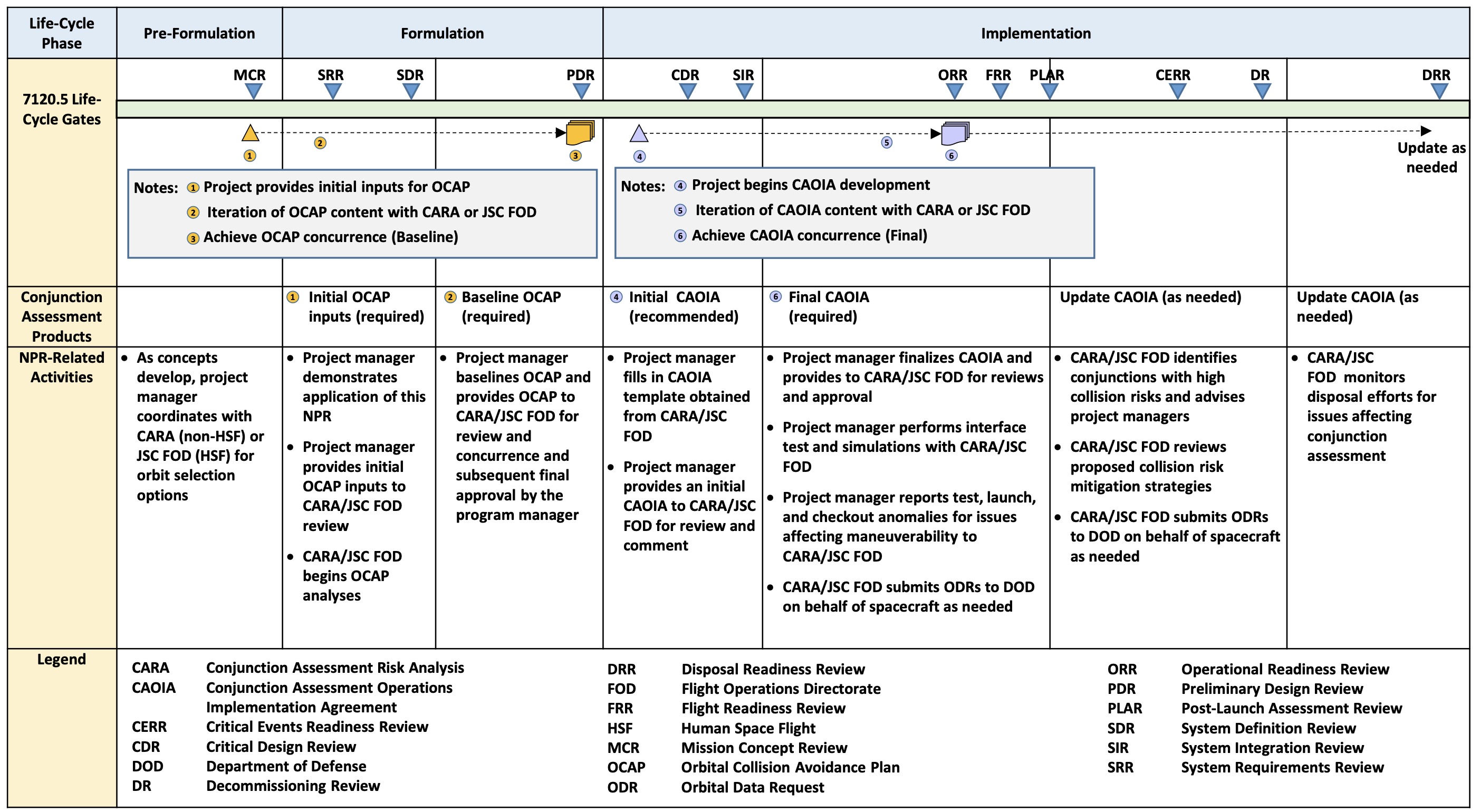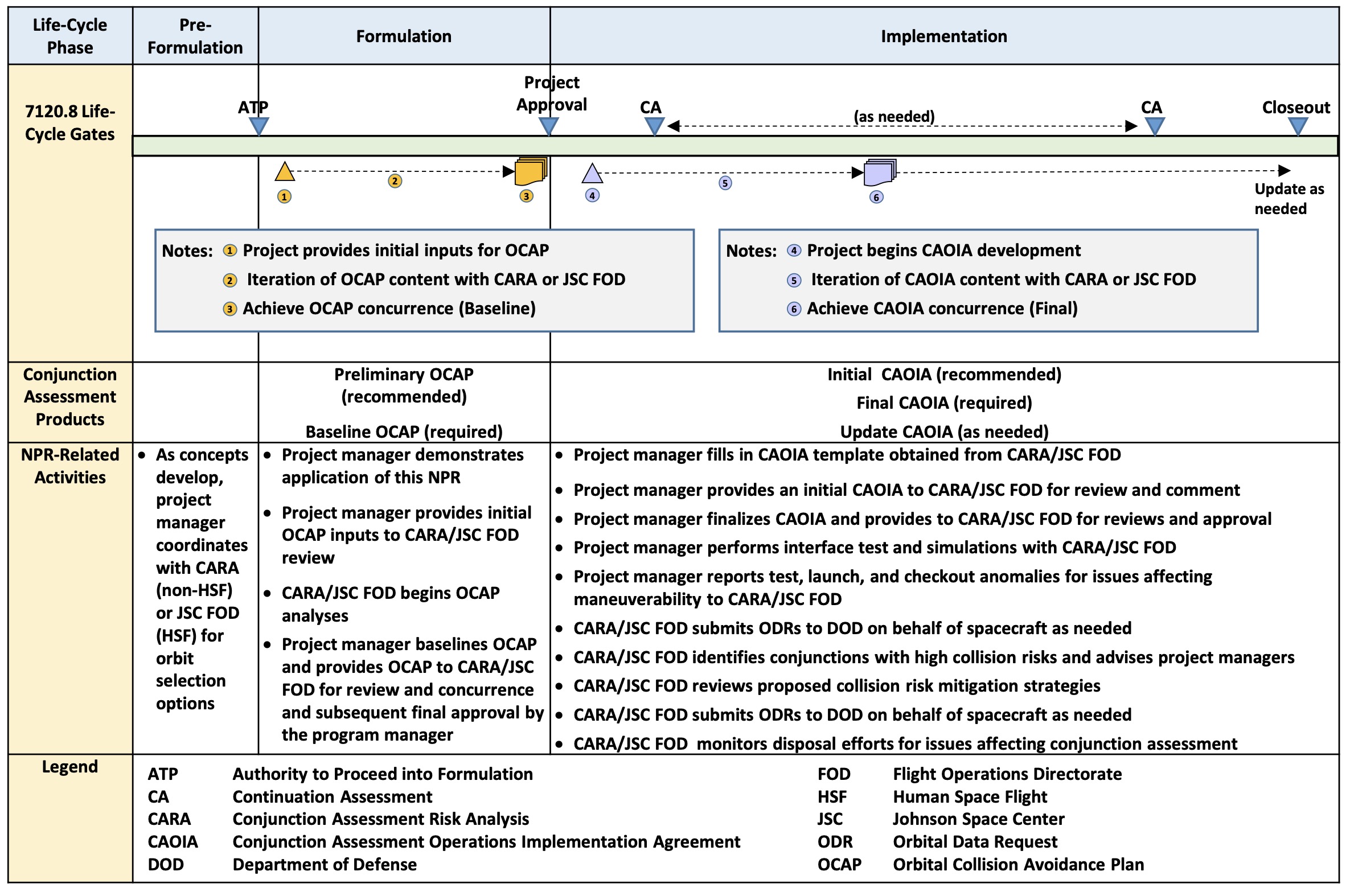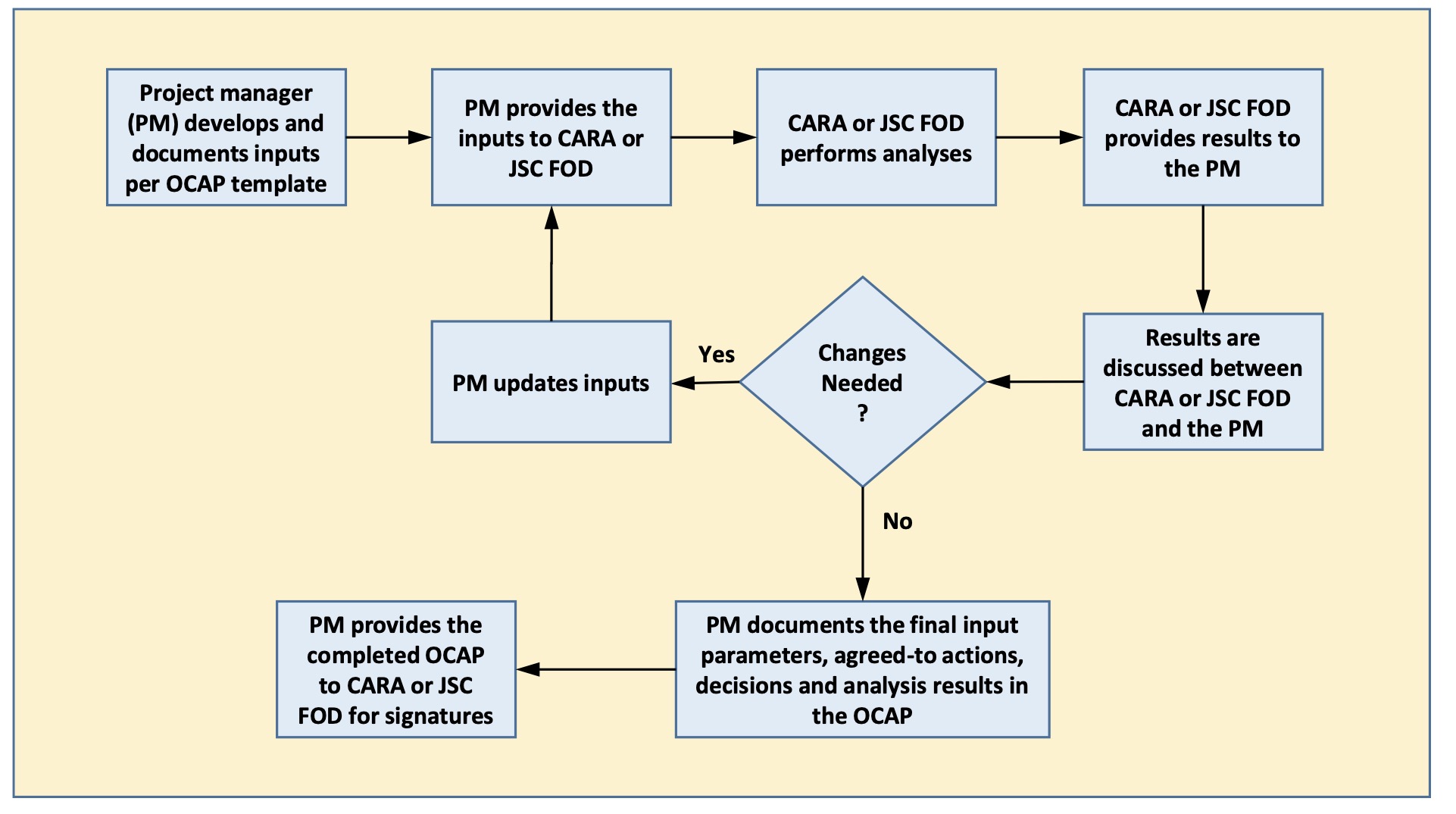
Procedural
Requirements
Effective Date: June 27, 2023
Expiration Date: June 27, 2028

|
NASA Procedural Requirements |
NPR 8079.1 Effective Date: June 27, 2023 Expiration Date: June 27, 2028 |
| | TOC | Preface | Chapter1 | Chapter2 | Chapter3 | Chapter4 | Chapter5 | AppendixA | AppendixB | AppendixC | AppendixD | AppendixE | AppendixF | ALL | |
3.1.1 The process for collision avoidance spans the program or project life-cycle involving key design choices, conjunction risk analysis, and operational mitigation. Early attention to the requirements in this directive can prevent costly redesigns later or unnecessary operational challenges.
3.1.2 The project manager shall ensure the spacecraft can be tracked from deployment until demise. Trackable spacecraft are essential for collision avoidance, including the time between disposal and demise. Trackability is analyzed by CARA or JSC FOD as part of the OCAP development. Trackability can be achieved through a variety of means depending on the spacecraft design, orbits, and available technical capabilities. (See the CA2 Handbook section on trackability.)
3.1.3 During early phase planning as project designs and the OCAP are developed, questions about orbital or trajectory conjunction risks are discussed with CARA (for non-HSF missions) or JSC FOD (for HSF missions). Involvement of CARA or JSC FOD early in the life-cycle establishes a relationship and allows for early advice and support for orbital or trajectory trade studies. CARA and JSC FOD can provide analytical support and suggestions on orbits to avoid or mitigation strategies to use for specific space flight mission planning scenarios. In the design and development phases, the project manager ensures that the spacecraft and ground systems include the capabilities necessary for operations.
3.1.4 As the designs progress to a final state, CARA or JSC FOD continues to provide support and document review to ensure all aspects of collision avoidance capabilities have been addressed. CARA also provides advice and support as the project begins development of the CAOIA, which will be baselined prior to flight. The CAOIA documents specific operational implementation processes.
3.1.5 Project managers ensure that the spacecraft, mission, and trajectory designs reduce the risk of collision as documented in the OCAP. Launch protection of crewed assets includes the gap (called the collision on launch assessment (COLA) gap) between the end of the time interval covered by standard launch collision avoidance screening and the point at which either the spacecraft moves beyond the risk of an Earth-orbit conjunction or the spacecraft is incorporated into the 18 SDS spacecraft catalog. Non-HSF missions perform COLA gap analysis only to protect crewed missions.
3.1.6 Table 3-1 shows the assessment and mitigation activities mapped against the life-cycle phases in NPR 7120.5, NASA Space Flight Program and Project Management Requirements. Table 3-2 shows the activities mapped against the life-cycle phases in NPR 7120.8, NASA Research and Technology Program and Project Management Requirements. The tables also show where the key OCAP and CAOIA products are provided in the life-cycles.
Table 3-1 Example Conjunction Assessment Activities Throughout an NPR 7120.5 Project Life-Cycle

Note: Section 3.2.7 provides more information on OCAP delivery.
Table 3-2 Example Conjunction Assessment Activities Throughout an NPR 7120.8 Project Life-Cycle
Note: Section 3.2.7 provides more information on OCAP delivery.
3.2.1 Project managers shall provide input to and work iteratively with CARA or JSC FOD to develop an OCAP that documents how the project will incorporate the capacity to meet the requirements of this directive into the design and operation of each spacecraft under their authority. The OCAP also includes design considerations for launch and deployment. CARA or JSC FOD reviews the completed OCAP and provides concurrence on the chosen implementation. The OCAP template containing the required elements is provided in Appendix D. NASA programs may develop OCAPs to cover multiple comparable spacecraft with mission-unique characteristics captured in separate appendices approved by CARA or JSC FOD.
3.2.2 The project manager provides the initial inputs shortly after approval for Formulation as shown in Figure 3-1 and as indicated in the instructions of Appendix D (template sections 1.0 and 2.0). CARA or JSC FOD responds with their analysis results, which are input into the analyses sections of the template. The results of the analyses are discussed between the project and CARA or JSC FOD. The resulting project decisions may be used to inform the design and operations of the spacecraft. The chosen course of action and rationale is then also documented in the OCAP. This process captures all the pertinent information, analyses, and plans in one document.
 Figure 3-1 Orbital Collision Avoidance Plan Flow
Figure 3-1 Orbital Collision Avoidance Plan Flow
3.2.3 The OCAP includes the information needed to review all phases of a space flight mission, providing for conjunction assessment and mitigation operations performed by the project manager or spacecraft owner. As a planning document, the OCAP has a broader applicability than solely the on-orbit conjunction assessment processes.
3.2.4 The OCAP includes as an attachment the Compliance Matrix that documents the project's acceptance or tailoring of the requirements of this NPR. The required Compliance Matrix is provided in Appendix C.
3.2.5 Per NPD 1000.0, NASA Governance and Strategic Management Handbook, tailoring is both accepted and expected. The Compliance Matrix documents the agreed-to tailoring of the requirements.
3.2.6 The information requested in the OCAP is illustrated in the plan template provided in Appendix D. The project manager obtains the latest version of the template from CARA or JSC FOD.
3.2.7 To secure concurrence for the OCAP from JSC FOD or CARA, project managers submit the OCAP to JSC FOD for HSF-related missions or to CARA for all other space flight missions. Project managers baseline the OCAP prior to proceeding into the Implementation Phase, or as otherwise negotiated with JSC FOD or CARA. When agreed to with JSC FOD or CARA, certain data values that are unknown at baseline (i.e., to-be-determined (TBD) and to-be-resolved (TBR) elements) may be filled in without additional approvals. JSC FOD and CARA provide feedback to the project manager within 30 days regarding further trade analysis or risk mitigation considerations if needed for concurrence. Program managers provide the final approval for the OCAP.
3.2.8 As changes occur, the project manager keeps the OCAP updated. The latest OCAP is made available for reviews and decision points. In general, the OCAP does not need to be updated after the CAOIA has been baselined.
3.3.1 The CAOIA documents the operational processes that the project implements to protect the space environment. For non-HSF-related missions, project managers implement the operational requirements specified in this NPR. For HSF-related missions, project managers implement the minimum operational requirements specified in this NPR with additional requirements specific to HSF projects established with JSC FOD in operational interface procedures, flight rules, and program jettison policies.
3.3.2 For HSF-related missions, project managers shall discuss with JSC FOD whether an agreement is needed (i.e., the CAOIA) that documents the conjunction assessment screening, conjunction risk assessment, conjunction mitigation steps, flight dynamics operations concept (including maneuvers), and the communication and coordination process between the project manager and JSC FOD.
3.3.3 For non-HSF-related missions, project managers shall establish with CARA an agreement (i.e., the CAOIA) that documents the conjunction assessment screening, conjunction risk assessment, conjunction mitigation steps, flight dynamics operations concept (including maneuvers), and the communication and coordination process between the project manager and CARA. Project managers are encouraged to engage with CARA early in the Implementation Phase to develop the CAOIA. Project managers obtain the most recent template for the CAOIA from CARA. (See Appendix E for a sample CAOIA table of contents. Operational requirements are detailed in chapters 4 and 5 of this directive.)
3.3.3.1 For projects governed by NPR 7120.5, the CAOIA is finalized by the Operational Readiness Review (ORR).
3.3.3.2 For projects governed by NPR 7120.8, the CAOIA is finalized by an appropriate pre-launch review such as a Continuation Assessment or Periodic Project Review as determined by the program manager.
3.3.4 When changes are needed to the flight dynamics operations concept (including maneuvers) captured in the approved CAOIA, the project manager shall provide updated information (e.g., orbital parameters or trajectory ephemeris) to CARA or JSC FOD 30 days prior to implementing the changes.
3.3.4.1 This requirement does not apply to routine maintenance and other maneuvers that are already captured in the CAOIA.
3.3.4.2 Thirty days is needed for CARA or JSC FOD to analyze the spacecraft trajectory for potential colocation or systematic conjunctions with other on-orbit assets. When negotiated prior to the 30-day cutoff, a shorter analysis period may be possible.
| TOC | Preface | Chapter1 | Chapter2 | Chapter3 | Chapter4 | Chapter5 | AppendixA | AppendixB | AppendixC | AppendixD | AppendixE | AppendixF | ALL | |
| | NODIS Library | Program Management(8000s) | Search | |
This document does not bind the public, except as authorized by law or as incorporated into a contract. This document is uncontrolled when printed. Check the NASA Online Directives Information System (NODIS) Library to verify that this is the correct version before use: https://nodis3.gsfc.nasa.gov.